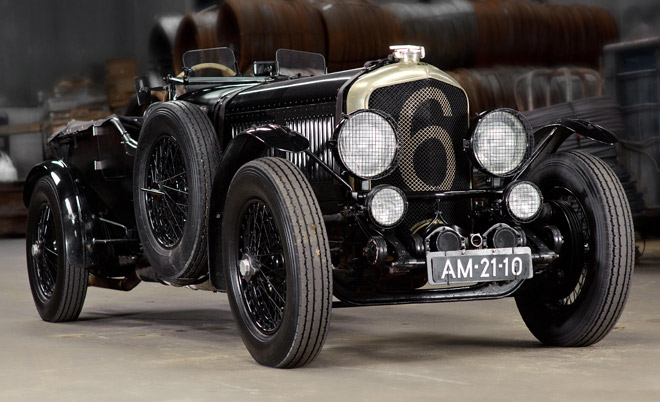This 6½ Litre Le Mans-style tourer offered here was constructed from parts by well-known Bentley collector/racer and VSCC competitor David Llewellyn. The car was upgraded with the engine block from an 8 Litre model.
The car started life fitted with Weymann-type saloon coachwork by H J Mulliner and was first owned by RHR Palmer, of Messrs Huntley & Palmer, the Reading-based biscuit manufacturer.
It was first registered in the U.K. on June 30, 1929, as RX3612, a Berkshire mark. The car is described in Bentley, The Vintage Years by Michael Hay (page 465).
David Llewellyn rebuilt the car as a copy of a Le Mans Speed Six, with replica Vanden Plas-type coachwork and to high-performance specification, its 8 Litre engine delivering tremendous torque.
The car?s restoration was completed in time for the 2007 Paris-Peking Rally Motor Challenge. It was bought by its current owner about 12 months ago, but he has not used it as much as he would have liked, so it is being sold. Currently registered in the Netherlands and eligible for a wide variety of the most prestigious events, FA2510 is described as an honest, trouble-free Bentley ready for the next owner to enjoy.
SCM Analysis
Detailing
| Vehicle: | 1929 Bentley 6½/8 Litre tourer |
This car, Lot 239, sold for $805,608, including buyer’s premium, at Bonhams? Paris Rétromobile auction at La Halle Freyssinet on February 2, 2012.
While stuffing 4½ Litre engines into Bentley 3 Litres is common — even traditional — Bentley practice, making hybrids out of the larger models isn?t so prevalent because of their fewer numbers. However, there are at least two 3 Litre chassis running with engines take from 8 Litres. One of those cars is turbocharged, and the other has a 24-litre Napier Lion W12 engine that started life in a torpedo boat.
There?s no substitute for cubes, which is obviously what Rolls-Royce thought when it bought Bentley in 1931. It immediately discontinued production of the 8 Litre and disposed of all the spare parts, believing it to be a competitor to its Phantom II.
In our subject car, the 8 Litre block (which is in unit with the overhead cam, four-valve head) is mounted backwards on the 6½ Litre crankcase, so that the engine retains the appearance of a 6½ — and still wears a 6½ engine number, as the original Elektron crankcase remains.
The gearbox is an original Bentley D-type, and the axles and steering column and box are genuine Bentley. After completion, the car was bought from Llewellyn by David Ayre, the Berkshire-based Bentley and Invicta specialist, who added a brake servo.
The car still runs the original type dual-ignition systems — magneto on one side and coil and distributor on the other, each firing a row of plugs via sensibly shielded wires to make sure it keeps firing — and a remote jack socket for the battery should it need a jump start. These are sensible rally mods, same as the right-hand throttle replacing the center pedal. The Jaeger speedo records 51,657 miles, although this is of no relevance to a rebuilt car that?s more than 80 years old.
Replacement body and chassis
Very few Bentleys retain their original bodies, mostly because of a combination of metal fatigue and fashion changes. So, the replacement Vanden Plas-style coachwork is no surprise, but the car — much less commonly — has a replacement chassis.
The chassis broke behind the front axle’s rear mountings during a tough transglobal expedition on some seriously rough roads. When the car got home, the broken chassis was replaced with a frame from VSCC member Julian Ghosh. As the original chassis was beyond saving, it was destroyed, and the replacement was stamped with the original chassis number. Some might see this practice as questionable, but it is a straight replacement part as a result of wear and tear. The broken original chassis was destroyed, meaning cloning the car is impossible.
Old collector cars are very often historically important, and you wouldn?t condemn a car just because it needed (or had) a replacement engine block.
Our subject car sits just right, like a Le Mans car that it replicates, with the characteristic front negative camber, big fuel tank and headlights (actually smaller H4s in the original shells) with mesh grilles and fold-down aero screens.
Leather bucket seats with an appealing patina only add to the appeal. The nickel-plated radiator shell with green label badge glows beautifully in warm light. The bonnet appears straight, although the car sits down a little at the rear — maybe as a result of the hammering it got on that rough rally.
Although the modern co-driver?s footrest looks incongruous, remember that this car is still in rally trim. Bentleys make highly suitable long-distance classic rally cars, and this one must have been hammered hard to break, although it was noted that the chassis had already been much repaired. With a new chassis, it should hold together indefinitely.
Priced as a high-end rally car
As far as value goes, leading vintage Bentley dealer Stanley Mann says a real 6½ Litre car would be in the realm of $1.2m — if it had its original engine and chassis. The high-performance version, the Speed Six, with impeccable history and provenance — such as a Le Mans win — would be worth nearer $1,875,000. Of the 545 Bentley 6½ Litres built from 1926 to 1930 (when 8 Litre production began), just 182 were Speed Sixes.
This bitsa managed a bit less than what the auctioneers thought the market could stand, and — provided you view it as a high-end rally weapon rather than a beautifully original car like the 4½ Litre we profiled last month — looks a slightly good buy.
